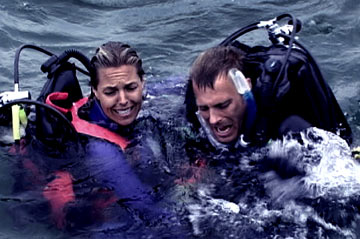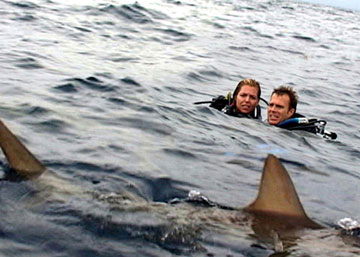Open Water


In Open Water, two stranded scuba divers face off against sharks. That's it. It's a simple, minimalistic concept, yet there is something very gripping and visceral about the movie. It's not as scary as the advertising makes it out to be, but there are some extremely intense moments where the two main characters are coming to terms with their own mortality. Events begin innocuously enough, as Susan (Blanchard Ryan, Bun-Bun, Exceed) and Daniel (Daniel Travis) head off to some unnamed island resort for some much needed vacation. The two are overworked, and looking forward to some scuba diving.
Apparently, other people are two. The boat they are on is crowded, and because of a mix-up, the boat leaves without them. Susan and Ryan surface, only to find that there is nothing around them. This idea itself is pretty frightening. Director Chris Kentis (Grind) milks it pretty much as far as it can go, then takes it a little further. Open Water is only seventy-nine minutes, and still feels overly long at times, even with an extended introduction. There is only so much that one can do with two people stuck in the middle of the ocean.
As the day wears on, it becomes increasingly clear that they are stuck and that nobody is going to find them. Passing ships and planes are too far away to contact. Susan and Daniel slowly run the gamut of the emotional spectrum in their reactions to their situation. Anger, at each other and the tour operators, despair, and even sarcasm slowly make their way to the surface. The two alternately freak out, console, and even joke with each other. Kentis structures Open Water such that things begin almost serenely, then slowly get worse. As the day goes by, Daniel and Susan see more and more evidence of sharks around them. Dorsal fins slice quickly through the water, and the water ominously splashes around them.
Here is where Open Water is at its best. Kentis used real sharks (although not with the actors) and got up close and personal, as the cameras show. Open Water was filmed in grainy digital, giving off a sense of hyperrealism that thrusts the viewer right there with the stranded couple. Susan and Daniel can only see what is directly in front of them, so when something bumps against their legs, their panic seems real. It works because the viewer is just as in the dark as they are. It's scarier imagining what might be happening than seeing what may or may not be going on. It's a good concept, but not substantial enough to merit an entire film.